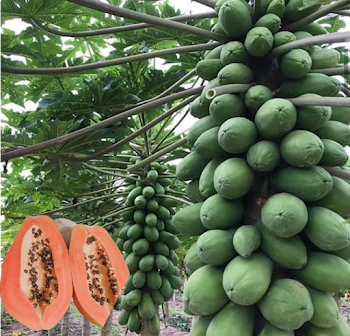Pawpaw, known scientifically as Carica papaya, is a tropical fruit celebrated for its sweet taste, vibrant color, and numerous health benefits. Native to Central America, it has found a favorable environment in countries like Ghana, where it thrives and contributes significantly to both nutrition and the economy.
Nutritional Profile of Pawpaw
Pawpaw is a nutrient-dense fruit, offering a variety of vitamins, minerals, and antioxidants essential for maintaining good health. A 100-gram serving of pawpaw provides approximately:
- Calories: 80
- Carbohydrates: 18.8 grams
- Dietary Fiber: 2.6 grams
- Protein: 1.2 grams
- Fat: 1.2 grams
- Vitamin C: 20% of the Daily Value (DV)
- Manganese: 113% of the DV
- Copper: 56% of the DV
- Iron: 39% of the DV
- Magnesium: 27% of the DV
- Potassium: 7% of the DV
This rich composition makes pawpaw a valuable addition to a balanced diet, supporting various bodily functions and promoting overall well-being.
Health Benefits of Pawpaw
Antioxidant Properties: Pawpaw is rich in antioxidants, including vitamins C and E, which help combat oxidative stress and may reduce the risk of chronic diseases.
Digestive Health: The enzyme papain present in pawpaw aids in the digestion of proteins, alleviating digestive disorders such as dyspepsia and constipation.
Immune System Support: High levels of vitamin C in pawpaw bolster the immune system, enhancing the body's ability to fend off infections.
Anti-Inflammatory Effects: Compounds found in pawpaw have been shown to reduce inflammation, which can be beneficial in managing conditions like asthma and arthritis.
Menstrual Health: Consumption of raw pawpaw can stimulate estrogen production, potentially aiding in the regulation of menstrual cycles.
Economic Importance of Pawpaw in Ghana
In Ghana, pawpaw cultivation plays a pivotal role in the agricultural sector, contributing to both local livelihoods and the national economy.
Export Revenue: Ghana is recognized as one of the leading exporters of pawpaw, particularly to the European Union market. Strategic investments in commercial pawpaw farming have the potential to boost the country's export earnings significantly.
Employment Opportunities: The pawpaw industry generates employment across various stages, including cultivation, harvesting, processing, and distribution, thereby supporting numerous households.
Value-Added Products: Beyond fresh fruit exports, there is a growing market for pawpaw-derived products such as juices, dried fruits, and cosmetic items, which can further enhance economic gains.
Culinary and Medicinal Uses
Pawpaw's versatility extends beyond its nutritional benefits, finding applications in both culinary and medicinal fields.
Culinary Uses: The sweet, custard-like pulp of pawpaw is enjoyed fresh or incorporated into various dishes, including smoothies, desserts, and salads. Its unique flavor profile adds a tropical twist to traditional recipes.
Medicinal Uses: Traditional medicine systems have utilized different parts of the pawpaw plant for their therapeutic properties. For instance, pawpaw leaf extracts are explored for potential antimalarial effects, while the seeds have been studied for their antimicrobial activities.
Conclusion
Pawpaw stands out as a fruit of considerable importance, offering a multitude of health benefits due to its rich nutritional profile. In Ghana, its cultivation not only supports economic development through export revenues and job creation but also enriches the culinary landscape and traditional medicinal practices. Embracing pawpaw in daily diets and recognizing its economic potential can contribute to improved health outcomes and sustainable economic growth.


